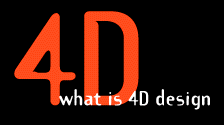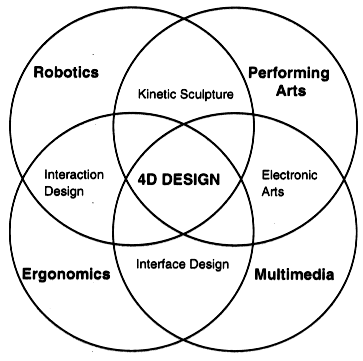Many years ago during my study for a Masters Degree in the Department of Design Research at the ROYAL COLLEGE OF ART , London under Professor Bruce Archer, it became clear to me that a new design frontier was emerging. A conclusion of my work "MICROPROCESSOR APPLICATION: SOME IMPLICATIONS FOR INDUSTRIAL DESIGN" was that the added value and usefulness of many new products would centre upon the design of complex dynamic and substantially non-material form what I began to call '4 Dimensional Design'. However, it was not until an enthusiastic and interesting discussion during the late 80's at the Royal College of Art, with the then Rector of the RCA Jocelyn Stevens, and Director of Industrial Design, Roger Sale, that it became clear design education would struggle with the cross-disciplinary collaboration 4D Design implies. The structures in place within education and professional demarcations posed serious problems. So I put 4D Design on ice. The time was not right. Then multimedia came along in the 90's The term, promoted by marketing hype of APPLE computers and IBM amongst others, and it is here to stay for a while. Although it incorporates much of what I am thinking of, one aspect it lacks is the potential for dynamic form that microchip control technology offers 'things'. So I picked up 4D Design again and developed it much further beyond a technological perspective into one concerning the design of dynamic form generally. I exposed my ideas in the early 1990's within DESIGN WEEK a popular paper for professional designers. I was encouraged by the response so I followed these up with an article in the DESIGN MANAGEMENT JOURNAL as the young discipline of Design Management might be a way forward to explore the multidisciplinary context, but it lacks a focus on 'designing'. So finally I decided to put a Conference together to discuss the notion further. In recent years there has been the development of 'Experience Design' and conferences on 'Design & Emotion'. The design of/for 'Experience' and 'Emotion' have always been fundamental within the 'art & design' perspective of 2D and 3D design. They are central to 4D Design too and the new interest goes along way to dealing with them, but they are usually related to 'static' form of 'objects'. Nevertheless it is pleasing to see this focus on them. The 4D Dynamics Conference I organised in 1995 brought together many authoritative people. One contributor I invited was Jeremy Myerson, writer and researcher for the design community, who has a wealth of experience in design criticism and comment. Jeremy's item in CREATIVE REVIEW, written a short while after the 1995 conference, communicated the complexities of the concept of 4D Design to a wide audience. It succinctly does this and I hope you enjoy it. At the end of the article are links to further information. Alec Robertson MA(RCA) FRSA Please scroll down.


CRUCIAL TIMINGby Jeremy MyersonArticle published by kind permission of CREATIVE REVIEW, Centaur Publishing Ltd., London. The elusive concept of the fourth dimension has captured the imagination of the design world. Jeremy Myerson reports on attempts to define what 4D means to design and to ensure that its exploitation is not confined to the insides of a computer. Suddenly people have started getting excited about the fourth dimension in design. `Not content with 2D design- print, posters, logos on a page - nor with 3D design, whether a car glued to a billboard or a retro-styled toaster, we have crossed the frontiers of time and space where no man has gone before, and lo, discovered 4D design. But where is this fourth dimension, and what is it like?
The chief area of debate centres on whether 4D design always belongs to the virtual worlds within your computer, or whether it can exist outside it. Up until now, the most vocal exponents of the fourth dimension in design have equated it largely with multimedia, in that designers trained in two dimensions and three dimensions must now grapple with moving images, sound and interactively in electronic visual communications. According to the traditional laws of physics, time has always been the fourth dimension, which would fit well with the ideas of the new time-based digital media. At the Netherlands Design Institute in Amsterdam, English director John Thackara has even planned his entire programme around three themes - 2D, 3D and 4D design. While 2D concerns graphic communication and 3D is all about craft and industrial artefacts, he defines 4D as being about electronic interactively. Thackara claims it to be "the biggest challenge to face the design professions since the Industrial Revolution". Thackara's Doors of Perception conference held in Amsterdam drew 4D design disciplines from all over Europe and, in one sense, reflected a rough consensus that the fourth dimension is largely governed by software. But nothing is ever that simple. According to Katherine McCoy, American queen of graphic theory, the new audio, movie and interactive channels mean designers could be said to have six dimensions, not three or four. Now that is really worrying, because where do we stop? McCoy and her Cranbrook Academy of Art students were responsible for deconstructing type in the 1980's, based on reading The French post-structuralist philosophers late into the night. Now McCoy frets that as design develops new dimensions, it may all become a case of too much too soon. "Will the seductivity of multi-media's hyper-dimensionality drown us in a soup of sensation?" she recently asked the Royal Society of Arts "Among techies it is rather unthinkable to ask if there is such a thing as too much bandwidth - but we must. When is less still more?" Not surprisingly, Katherine McCoy prefers the concept of "unimedia" to multimedia, in which the true paradigm for the electronic era is design convergence. But the story doesn't stop there, with the proliferation of design dimensions inside the computer. Now design practitioners from a variety of adjacent fields -performance art, theatre, robotics, architecture and interiors - are promoting the notion that a 4D design or dynamic is developing outside the simulated software creations, which traditional design methodologies with a maximum of three dimensions have been too limited to capture. British heavyweight champion of this viewpoint is De Montfort University design educator Alec Robertson, who argues that 4D design is " dynamic form resulting from the design of the behaviour of artefacts and people in relation to each other and their environment". In other words, 4D design can be about multimedia, but also much else besides - intelligent buildings, smart products, choreographed service environments and so on.
The emerging technologies of robotics and mechatronics - bringing movement to the inanimate object and offering enormous potential, incidentally, for creatives of tomorrow -could be said to occupy a fourth design dimension, alongside new electronic media. But then so could simple interior space. As De Montfort University interior designer Paul Martin explained, the dimensions of floors and ceilings may define volumes but fail utterly to capture "the space within". How does one chart the movement of people and the changes in daylight if not through the fourth dimension? The most dramatic exchanges were between design and the world of performance/theatre, whose own methodologies have been shaken up by new technologies. As dance and choreography academic Mike Huxley explains: "Tens years ago we watched performance art by Laurie Anderson on stage. Now she performs on CD-Rom. This creates new conceptual challenges." Theatre techniques adopted in commercial environments reinforce the view that 4D design is not just about information technology. Performance expert Nicholas Arnold told the 4D Dynamics conference about a concept called "invisible theatre" in which the actors play out barely perceptible choreographed movements in crowded shopping malls over two or three hours. One group will hold a pose on the up escalator while the other passes them holding the same pose going down, looking, he says, uncannily like a "row of dominoes". Arnold terms this work "design for living" and predicts a role for it within unsympathetic architecture. But take the concept on and apply it to service environments in which the entire choreography of the user experience must be designed - the interface with the particular airline at an airport, for example - and you begin to see how 4D design, both real and virtual, can be important. Both British Airways and Virgin orchestrate various 2D and 3D design elements (from tags, tickets and liveries to executive trolleys and executive lounges) to express corporate personality. Colours, textures and dimensions may differentiate between the two rivals up to a point. But it is in a fourth physical dimension - involving customer response to the interface with the environment, and the ritual of movement in space through the facilities - that the true point of difference will be achieved. Go further and unite the characteristics of this fourth dimension with the disciplines of direct
marketing, advertising and image-building, so that, say, British Airways' interactive media for buying
tickets, its commercials and its corporate identity all enjoy the same 4D dynamic then you really have
a powerful creative tool in business. Concept Diagram by Alec Robertson (Click to enlarge then BACK to return)
Jeremy Myerson is a design writer and Professor of Contemporary Design of the School of Design & Manufacture at De Montfort University, England. Click for
|


 In September (1995), Robertson organised a major conference on the subject in Leicester (UK), entitled
In September (1995), Robertson organised a major conference on the subject in Leicester (UK), entitled


